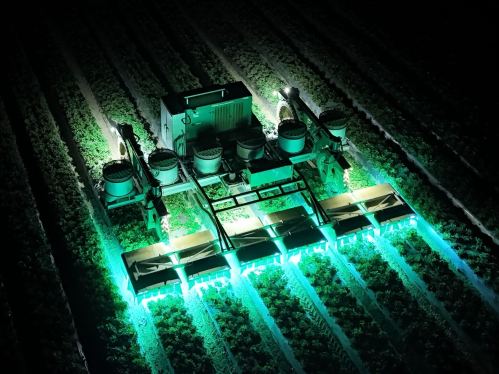Strawberries are the most popular berry in the United States, loved by both consumers and farmers alike. However, they are also among the most pesticide-reliant fruits and consistently top the Environmental Working Group’s “Dirty Dozen” list of the most contaminated produce.
A promising solution comes from TRIC Robotics, a San Luis Obispo, California-based startup that aims to help strawberry farmers reduce chemical use through the use of UV light and robotics technology. TRIC Robotics has developed a fleet of autonomous, tractor-sized robots equipped with UV-C light, a type of ultraviolet light that is largely blocked by the earth’s atmosphere. This light effectively kills bacteria and damages pest populations, offering a chemical-free way to protect crops. Additionally, these robots are fitted with vacuums designed to suck up bug residue without harming the plants.
The company operates its robots as a service, running them overnight on farms rather than selling the machines directly to farmers. While this approach is harder to scale, TRIC’s co-founder and CEO, Adam Stager, explained that it allows the company to gain traction more quickly. “We worked closely with farmers to understand the best way to launch the technology and what business model made the most sense,” Stager said. “We found that many farmers already pay for pest and disease control as a service, bringing companies in to perform spraying. What we’re doing is simply replacing that service with our robotic solution.”
Interestingly, TRIC Robotics wasn’t always focused on agriculture. Stager founded the company in 2017 after completing his PhD in robotics, initially focusing on 3D-printed robots for SWAT teams. In 2020, he pivoted toward agriculture, believing it was an area where he could have a greater positive impact. “I wanted to answer the question, if you were to die tomorrow, would you be happy with what you accomplished?” Stager shared. “I realized agriculture is a field where we can impact many people, basically everyone.”
To develop their technology, Stager reached out to the United States Department of Agriculture (USDA) to explore if there was existing research that could be commercialized. This led him to a USDA program that connects entrepreneurs with scientists developing technology that hadn’t yet reached the market. Through this connection, TRIC Robotics gained access to the UV light technology that became the foundation of their robotic solutions.
Stager and co-founder Vishnu Somasundaram began their journey in 2021 by loading two robots they built in a garage onto an SUV and traveling cross-country with the support of farmers willing to lend them just a small piece of land for testing. This period involved living on Airbnbs for eight months, deploying their robots, and gathering valuable data with farmers.
Today, TRIC Robotics, which also includes co-founder Ryan Berard, collaborates with four large strawberry producers and has deployed nine robots, with three more in development. The company recently secured a $5.5 million seed funding round led by Version One Ventures, with participation from Garage Capital, Todd and Rahul Capital, Lucas Venture Group, and several angel investors. These funds will support the expansion of TRIC’s autonomous robot fleet and future plans to branch out into other crop types.
Looking ahead, Stager is optimistic about the future of agricultural technology. “There is a really bright future for ag tech,” he said. “Things are moving in a great direction, and there are a lot of exciting innovations to come.”

